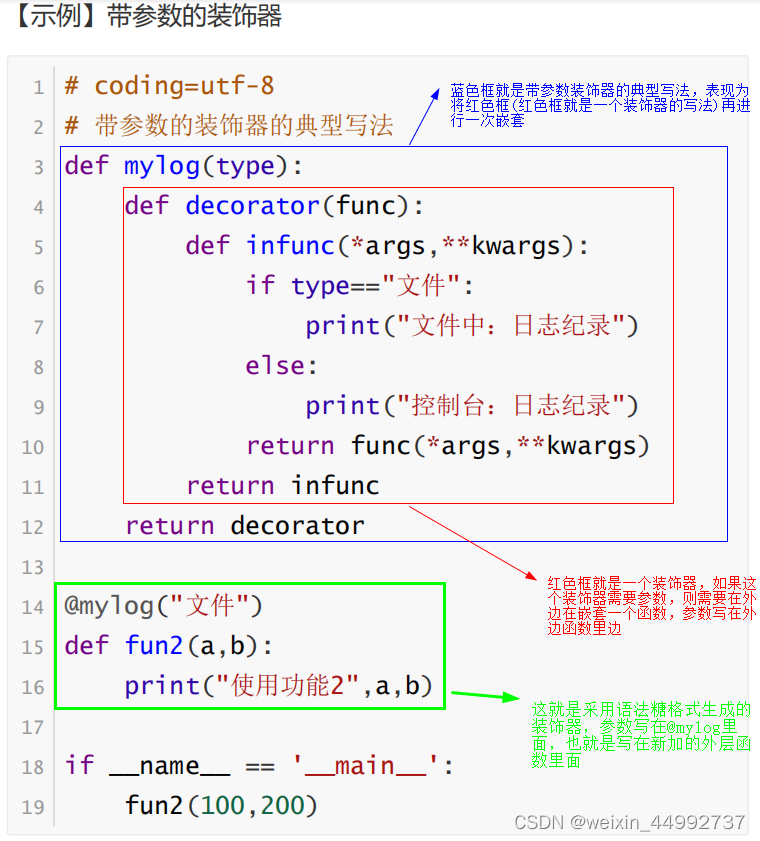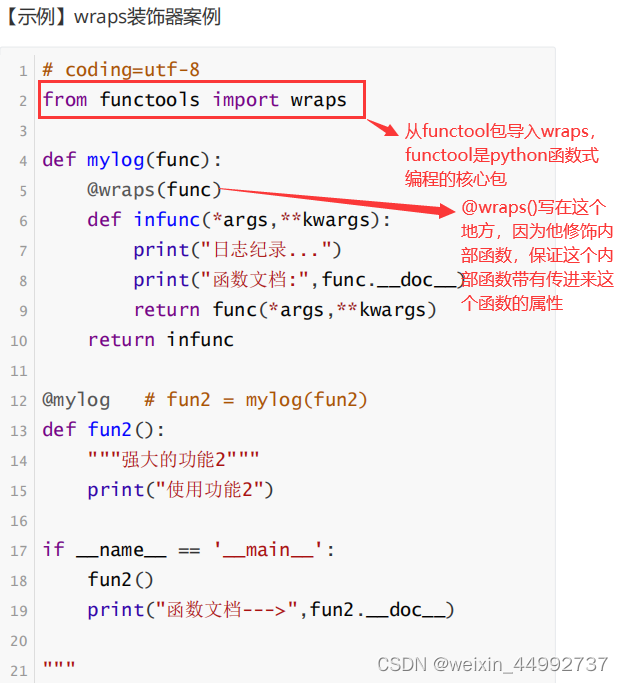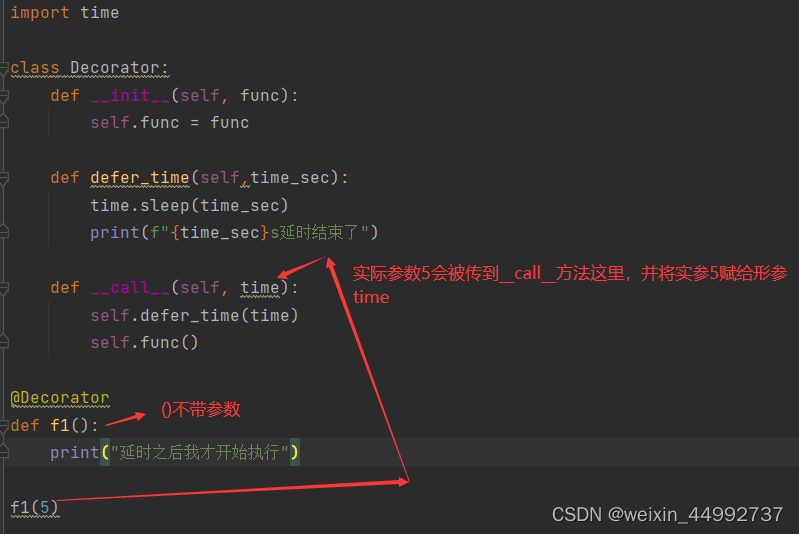classification
no classification
tag
no tag
date
no datas
python装饰器详解
posted on 2023-05-03 20:56 read(489) comment(0) like(13) collect(1)
The decorator in python generally takes the form of syntactic sugar, which is a grammatical format. For example: @classmethod, @staticmethod, @property, @xxx.setter, @wraps(), @func_name, etc. are all decorators in python.
Decorator, the decorated object is a function or method. The functions of various decorators are the same: to change the function and nature of the decorated function or method.
The following mainly explains the two decorators @wraps(), @func_name, and class decorators.
Table of contents
1. The official definition of the decorator
Second, add a decorator to a function
2. Standard grammatical sugar writing
Second, add multiple decorators to a function
2.1 Add two decorators to a function
2.2 Execution order when a function has two decorators
3. Typical writing method with parameter decorator
Fourth, @wraps() syntax sugar (understand)
1. Class decorator without parameters
2. Class decorator with parameters
1. The official definition of the decorator
A decorator is essentially a Python function (actually a closure), which allows other functions to add additional functions without any code changes. The return value of the decorator is also a function object. Decorators are used in the following scenarios, such as: inserting logs, performance testing, transaction processing, caching, permission verification and other scenarios.
Second, add a decorator to a function
1. General writing
- # 为函数添加一个统计运行时长的功能
- import time
-
- def how_much_time(func):
- def inner():
- t_start = time.time()
- func()
- t_end = time.time()
- print("一共花费了{0}秒时间".format(t_end - t_start, ))
- return inner
- # 将增加的新功能代码以及被装饰函数运行代码func()一同打包返回,返回的是一个内部函数,这个被返回的函数就是装饰器
-
- def sleep_5s():
- time.sleep(5)
- print("%d秒结束了" % (5,))
-
- def sleep_6s():
- time.sleep(6)
- print("%d秒结束了" % (6,))
-
- sleep_5s = how_much_time(sleep_5s)
- # 因为sleep_5s函数的功能就是睡5秒钟,虽然增加了统计运行时间的功能,但是他本身功能没变(还是睡5秒钟),所以仍然用原来函数名接收增加功能了的自己
- sleep_6s = how_much_time(sleep_6s)
-
- t1 = threading.Thread(target=sleep_5s)
- t2 = threading.Thread(target=sleep_6s)
- t1.start()
- t2.start()
- # 5秒结束了
- # 一共花费了5.014161109924316秒时间
- # 6秒结束了
- # 一共花费了6.011810302734375秒时间

2. Standard grammatical sugar writing
- # 为函数添加一个统计运行时长的功能
- import time
- import threading
-
- def how_much_time(func):
- def inner():
- t_start = time.time()
- func()
- t_end = time.time()
- print("一共花费了{0}秒时间".format(t_end - t_start, ))
-
- return inner
-
-
- @how_much_time
- # @how_much_time等价于sleep_5s = how_much_time(sleep_5s)
- def sleep_5s():
- time.sleep(5)
- print("%d秒结束了" % (5,))
-
- @how_much_time
- def sleep_6s():
- time.sleep(6)
- print("%d秒结束了" % (6,))
-
- t1 = threading.Thread(target=sleep_5s)
- t2 = threading.Thread(target=sleep_6s)
- t1.start()
- t2.start()
-

Second, add multiple decorators to a function
Here is an example of adding two decorators.
2.1 Add two decorators to a function
- # 为函数添加一个统计运行时长的功能以及日志记录功能
- import time
- import threading
-
- def how_much_time(func):
- print("how_much_time函数开始了")
- def inner():
- t_start = time.time()
- func()
- t_end = time.time()
- print("一共花费了{0}秒时间".format(t_end - t_start, ))
- return inner
-
- def mylog(func):
- print("mylog函数开始了")
- def inner_1():
- print("start")
- func()
- print("end")
- return inner_1
-
- @mylog
- @how_much_time
- # 等价于mylog(how_much_time(sleep_5s))
- def sleep_5s():
- time.sleep(5)
- print("%d秒结束了" % (5,))
-
- if __name__ == '__main__':
- sleep_5s()
- #how_much_time函数开始了
- #mylog函数开始了
- #start
- #5秒结束了
- #一共花费了5.012601613998413秒时间
- #end

2.2 Execution order when a function has two decorators

3. Typical writing method with parameter decorator

Fourth, @wraps() syntax sugar (understand)
Because the decorator is essentially a function, a modified function, it is two different function objects from the original undecorated function.
Therefore, this decorator loses some attributes of the original function object, such as: __name__, __doc__ and other attributes. These properties can be preserved using wraps syntactic sugar.

Five, class decorator
The main idea of writing a class decorator is to return a function object with new functions added, but this function object is an instance object of a class. Since the decorator is a callable object, the __call__ method must be implemented in the class, so that various instances generated by the class can be run by adding ().
1. Class decorator without parameters
- import time
-
-
- class Decorator:
- def __init__(self, func):
- self.func = func
-
- def defer_time(self):
- time.sleep(5)
- print("延时结束了")
-
- def __call__(self, *args, **kwargs):
- self.defer_time()
- self.func()
-
-
- @Decorator
- def f1():
- print("延时之后我才开始执行")
-
-
- f1()

2. Class decorator with parameters
- import time
-
- class Decorator:
- def __init__(self, func):
- self.func = func
-
- def defer_time(self,time_sec):
- time.sleep(time_sec)
- print(f"{time_sec}s延时结束了")
-
- def __call__(self, time):
- self.defer_time(time)
- self.func()
-
- @Decorator
- def f1():
- print("延时之后我才开始执行")
-
- f1(5)


Category of website: technical article > Blog
Author:python98k
link:http://www.pythonblackhole.com/blog/article/255/9fbe565f5e0621870dbf/
source:python black hole net
Please indicate the source for any form of reprinting. If any infringement is discovered, it will be held legally responsible.
name:
Comment content: (supports up to 255 characters)